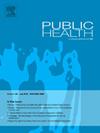高体重指数对全球HBV/ hcv相关肝癌负担的协同影响:1990-2050年的分析和预测
IF 3.2
3区 医学
Q1 PUBLIC, ENVIRONMENTAL & OCCUPATIONAL HEALTH
引用次数: 0
摘要
目的量化和预测1990 - 2050年全球、地区和国家由高体重指数(BMI)引起的乙型肝炎病毒(HBV)和丙型肝炎病毒(HCV)相关肝癌的疾病负担。研究设计一项利用GBD 2021数据分析的全球负担和预测研究。方法分析来自2021年全球疾病负担(GBD)研究的数据,以估计全球和各地区与高BMI导致的HBV/ hcv相关肝癌相关的死亡、残疾调整生命年(DALYs)和年龄标准化率(ASRs)。利用估计年百分比变化(EAPC)和分层聚类分析评估了1990 - 2021年的时间趋势。预测2050年疾病负担采用自回归综合移动平均(ARIMA)和指数平滑(ES)模型。结果2021年,全球范围内,高BMI导致约15,698例hbv相关死亡和17,090例hcv相关死亡,自1990年以来显著增加。男性和老年人群的负担较高,并表现出明显的区域差异,中国的负担最重,中亚、大洋洲和北美的负担增加趋势显著。预测模型预测,到2050年,高BMI导致的肝癌负担将继续上升。结论高BMI导致的HBV/ hcv相关肝癌的疾病负担在全球范围内显著增加,并有进一步上升的趋势。迫切需要将病毒性肝炎控制与肥胖预防相结合的公共卫生行动,以减轻未来的疾病负担。本文章由计算机程序翻译,如有差异,请以英文原文为准。
Synergistic impact of high body-mass index on HBV/HCV-related liver cancer burden globally: Analysis and projections 1990–2050
Objectives
To quantify and forecast the global, regional, and national disease burden of hepatitis B virus (HBV) and hepatitis C virus (HCV)-related liver cancer attributable to high body-mass index (BMI) from 1990 to 2050.
Study Design
A global burden and projection study utilizing GBD 2021 data analysis.
Methods
Data from the Global Burden of Disease (GBD) Study 2021 were analyzed to estimate deaths, disability-adjusted life years (DALYs), and age-standardized rates (ASRs) associated with HBV/HCV-related liver cancer attributable to high BMI globally and across regions. Temporal trends from 1990 to 2021 were assessed using estimated annual percentage change (EAPC) and hierarchical cluster analysis. Forecasts for disease burden to 2050 employed Autoregressive Integrated Moving Average (ARIMA) and exponential smoothing (ES) models.
Results
In 2021, globally, high BMI contributed to approximately 15,698 HBV-related deaths and 17,090 HCV-related deaths, a marked increase since 1990. Burdens were higher among males, older populations, and exhibited substantial regional variations, with the greatest burden observed in China and increasing trends notable in Central Asia, Australasia, and North America. Forecasting models project a continued rise in liver cancer burden attributable to high BMI through 2050.
Conclusions
The disease burden of HBV/HCV-related liver cancer attributable to high BMI has significantly increased globally and is projected to further rise. Public health initiatives integrating viral hepatitis control with obesity prevention are urgently needed to mitigate future disease burdens.
求助全文
通过发布文献求助,成功后即可免费获取论文全文。
去求助
来源期刊

Public Health
医学-公共卫生、环境卫生与职业卫生
CiteScore
7.60
自引率
0.00%
发文量
280
审稿时长
37 days
期刊介绍:
Public Health is an international, multidisciplinary peer-reviewed journal. It publishes original papers, reviews and short reports on all aspects of the science, philosophy, and practice of public health.
 求助内容:
求助内容: 应助结果提醒方式:
应助结果提醒方式:


